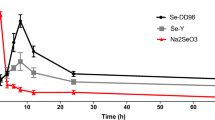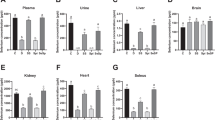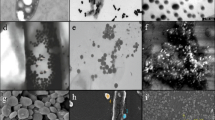Abstract
Selenium (Se) is an essential micronutrient, and animals biosynthesize selenoproteins from various selenocompounds such as inorganic salts and organic selenocompounds as a Se source. In addition to the inorganic and organic forms of Se, it is also known that elemental Se is biologically synthesized at the nanoscale in nature. Biologically synthesized Se nanoparticles (Se-NPs), i.e., biogenic Se-NPs (Se-BgNPs), have not been fully investigated as a Se source compared with the other forms of Se. In this study, we evaluated the nutritional availability of Se-BgNPs biosynthesized in E. coli and revealed that Se-BgNPs were less assimilated into selenoproteins in rats as a Se source than inorganic Se salt or chemically synthesized Se-NPs. Se-BgNPs showed tolerance toward digestion and low absorbability in gut, which resulted in the low nutritional availability. Se-BgNPs seem to be coated with a biomaterial that functions to reduce their toxicity toward E. coli and at the same time lowers their availability to animals.






Similar content being viewed by others
Data Availability
The datasets used and/or analyzed during the current study are available from the corresponding author upon reasonable request.
References
Kryukov GV, Castellano S, Novoselov SV et al (2003) Characterization of mammalian selenoproteomes. Science 300:1439–1443. https://doi.org/10.1126/science.1083516
Dinh QT, Cui Z, Huang J et al (2018) Selenium distribution in the Chinese environment and its relationship with human health: a review. Environ Int 112:294–309
Rayman MP (2008) Food-chain selenium and human health: emphasis on intake. Br J Nutr 100:254–268. https://doi.org/10.1017/S0007114508939830
Fordyce FM (2013) Selenium deficiency and toxicity in the environment. Essentials Med Geol Revis Ed 375–416. https://doi.org/10.1007/978-94-007-4375-5_16
Deng H, Liu H, Yang Z et al (2021) Progress of selenium deficiency in the pathogenesis of arthropathies and selenium supplement for their treatment. Biol Trace Elem Res 1–12. https://doi.org/10.1007/S12011-021-03022-4
Zhou H, Wang T, Li Q, Li D (2018) Prevention of Keshan disease by selenium supplementation: a systematic review and meta-analysis. Biol Trace Elem Res 186:98–105. https://doi.org/10.1007/s12011-018-1302-5
Lönnerdal B, Vargas-Fernández E, Whitacre M (2017) Selenium fortification of infant formulas: does selenium form matter? Food Funct 8:3856–3868. https://doi.org/10.1039/C7FO00746A
Dernovics M, Far J, Lobinski R (2009) Identification of anionic selenium species in Se-rich yeast by electrospray QTOF MS/MS and hybrid linear ion trap/orbitrap MS. Metallomics 1:317. https://doi.org/10.1039/b901184f
Alehagen U, Aaseth J, Alexander J et al (2020) Selenium and coenzyme Q10 supplementation improves renal function in elderly deficient in selenium: observational results and results from a subgroup analysis of a prospective randomised double-blind placebo-controlled trial. Nutrients 12:3780. https://doi.org/10.3390/nu12123780
Radomska D, Czarnomysy R, Radomski D et al (2021) Selenium as a bioactive micronutrient in the human diet and its cancer chemopreventive activity. Nutrients 13:1649. https://doi.org/10.3390/nu13051649
Li G, Lee H-J, Wang Z et al (2008) Superior in vivo inhibitory efficacy of methylseleninic acid against human prostate cancer over selenomethionine or selenite. Carcinogenesis 29:1005–1012. https://doi.org/10.1093/carcin/bgn007
Zeng H, Cheng W-H, Johnson LK (2013) Methylselenol, a selenium metabolite, modulates p53 pathway and inhibits the growth of colon cancer xenografts in Balb/c mice. J Nutr Biochem 24:776–780. https://doi.org/10.1016/j.jnutbio.2012.04.008
Lin W, Zhang J, Xu J-F, Pi J (2021) The advancing of selenium nanoparticles against infectious diseases. Front Pharmacol 12:1971. https://doi.org/10.3389/fphar.2021.682284
Nabi F, Arain MA, Hassan F et al (2020) Nutraceutical role of selenium nanoparticles in poultry nutrition: a review. Worlds Poult Sci J 76:459–471. https://doi.org/10.1080/00439339.2020.1789535
Zhang J, Wang X, Xu T (2008) Elemental selenium at nano size (nano-Se) as a potential chemopreventive agent with reduced risk of selenium toxicity: comparison with Se-methylselenocysteine in mice. Toxicol Sci 101:22–31. https://doi.org/10.1093/toxsci/kfm221
Bhattacharjee A, Basu A, Bhattacharya S (2019) Selenium nanoparticles are less toxic than inorganic and organic selenium to mice in vivo. The Nucleus 62:259–268. https://doi.org/10.1007/s13237-019-00303-1
Zou X, Jiang Z, Li L, Huang Z (2021) Selenium nanoparticles coated with pH responsive silk fibroin complex for fingolimod release and enhanced targeting in thyroid cancer. Artif Cells Nanomed Biotechnol 49:83–95. https://doi.org/10.1080/21691401.2021.1871620
Shirsat S, Kadam A, Naushad M, Mane RS (2015) Selenium nanostructures: microbial synthesis and applications. RSC Adv 5:92799–92811. https://doi.org/10.1039/C5RA17921A
Schröder I, Rech S, Krafft T, Macy JM (1997) Purification and characterization of the selenate reductase from Thauera selenatis. J Biol Chem 272:23765–23768. https://doi.org/10.1074/jbc.272.38.23765
Tugarova AV, Vetchinkina EP, Loshchinina EA et al (2014) Reduction of selenite by Azospirillum brasilense with the formation of selenium nanoparticles. Microb Ecol 68:495–503. https://doi.org/10.1007/s00248-014-0429-y
Kessi J, Hanselmann KW (2004) Similarities between the abiotic reduction of selenite with glutathione and the dissimilatory reaction mediated by Rhodospirillum rubrum and Escherichia coli. J Biol Chem 279:50662–50669. https://doi.org/10.1074/jbc.M405887200
Lampis S, Zonaro E, Bertolini C et al (2017) Selenite biotransformation and detoxification by Stenotrophomonas maltophilia SeITE02: novel clues on the route to bacterial biogenesis of selenium nanoparticles. J Hazard Mater 324:3–14. https://doi.org/10.1016/j.jhazmat.2016.02.035
Cremonini E, Boaretti M, Vandecandelaere I et al (2018) Biogenic selenium nanoparticles synthesized by Stenotrophomonas maltophilia SeITE02 loose antibacterial and antibiofilm efficacy as a result of the progressive alteration of their organic coating layer. Microb Biotechnol 11:1037–1047. https://doi.org/10.1111/1751-7915.13260
Shimizu A, Tobe R, Aono R et al (2021) Initial step of selenite reduction via thioredoxin for bacterial selenoprotein biosynthesis. Int J Mol Sci 22:10965. https://doi.org/10.3390/IJMS222010965
Takahashi K, Ruiz Encinar J, Costa-Fernández JM, Ogra Y (2021) Distributions of mercury and selenium in rats ingesting mercury selenide nanoparticles. Ecotoxicol Environ Saf 226:112867. https://doi.org/10.1016/j.ecoenv.2021.112867
Fang Y, Catron B, Zhang Y et al (2010) Distribution and in vitro availability of selenium in selenium-containing storage protein from selenium-enriched rice utilizing optimized extraction. J Agric Food Chem 58:9731–9738. https://doi.org/10.1021/jf100934p
Tugarova AV, Mamchenkova PV, Dyatlova YA, Kamnev AA (2018) FTIR and Raman spectroscopic studies of selenium nanoparticles synthesised by the bacterium Azospirillum thiophilum. Spectrochim Acta Part A Mol Biomol Spectrosc 192:458–463. https://doi.org/10.1016/j.saa.2017.11.050
Anan Y, Hatakeyama Y, Tokumoto M, Ogra Y (2013) Chromatographic behavior of selenoproteins in rat serum detected by inductively coupled plasma mass spectrometry. Anal Sci 29:787–792. https://doi.org/10.2116/analsci.29.787
Takahashi K, Suzuki N, Ogra Y (2017) Bioavailability comparison of nine bioselenocompounds in vitro and in vivo. Int J Mol Sci 18:506. https://doi.org/10.3390/ijms18030506
Takahashi K, Suzuki N, Ogra Y (2018) Effect of administration route and dose on metabolism of nine bioselenocompounds. J Trace Elem Med Biol 49:113–118. https://doi.org/10.1016/j.jtemb.2018.05.007
Suzuki KT (2005) Metabolomics of selenium: Se metabolites based on speciation studies. J Heal Sci 51:107–114. https://doi.org/10.1248/jhs.51.107
Suzuki KT, Shiobara Y, Itoh M, Ohmichi M (1998) Selective uptake of selenite by red blood cells†. Analyst 123:63–67. https://doi.org/10.1039/A706230C
Clark NJ, Woznica W, Handy RD (2020) Dietary bioaccumulation potential of silver nanomaterials compared to silver nitrate in Wistar rats using an ex vivo gut sac technique. Ecotoxicol Environ Saf 200:110745. https://doi.org/10.1016/j.ecoenv.2020.110745
Sonavane G, Tomoda K, Sano A et al (2008) In vitro permeation of gold nanoparticles through rat skin and rat intestine: effect of particle size. Colloids Surfaces B Biointerfaces 65:1–10. https://doi.org/10.1016/j.colsurfb.2008.02.013
Huang K, Ma H, Liu J et al (2012) Size-dependent localization and penetration of ultrasmall gold nanoparticles in cancer cells, multicellular spheroids, and tumors in vivo. ACS Nano 6:4483–4493. https://doi.org/10.1021/nn301282m
Wang Y, Chen P, Zhao G et al (2015) Inverse relationship between elemental selenium nanoparticle size and inhibition of cancer cell growth in vitro and in vivo. Food Chem Toxicol 85:71–77. https://doi.org/10.1016/j.fct.2015.08.006
Huang T, Holden JA, Heath DE et al (2019) Engineering highly effective antimicrobial selenium nanoparticles through control of particle size. Nanoscale 11:14937–14951. https://doi.org/10.1039/C9NR04424H
Zhang J, Wang H, Bao Y, Zhang L (2004) Nano red elemental selenium has no size effect in the induction of seleno-enzymes in both cultured cells and mice. Life Sci 75:237–244. https://doi.org/10.1016/j.lfs.2004.02.004
Kamnev AA, Mamchenkova PV, Dyatlova YA, Tugarova AV (2017) FTIR spectroscopic studies of selenite reduction by cells of the rhizobacterium Azospirillum brasilense Sp7 and the formation of selenium nanoparticles. J Mol Struct 1140:106–112. https://doi.org/10.1016/j.molstruc.2016.12.003
Jain R, Jordan N, Weiss S et al (2015) Extracellular polymeric substances govern the surface charge of biogenic elemental selenium nanoparticles. Environ Sci Technol 49:1713–1720. https://doi.org/10.1021/es5043063
Takahashi K, Suzuki N, Ogra Y (2020) Effect of gut microflora on nutritional availability of selenium. Food Chem 319:126537. https://doi.org/10.1016/j.foodchem.2020.126537
Acknowledgements
We thank Dr. Daiki Fujioka, Japan Synchrotron Radiation Institute, for technical assistance in SEM analysis.
Funding
This study was supported by JSPS KAKENHI Grants (Numbers 19H01081, 19H05772, 20J10577, 20H02907, 20J40237, 21H04920, and 22H04823) and by the Institute for Fermentation, Osaka (Grant number G-2019–2-055).
Author information
Authors and Affiliations
Contributions
The manuscript was written through contributions of all authors. All authors have given approval to the final version of the manuscript. Kazuaki Takahashi: conceptualization, methodology, investigation, writing—original draft, writing—review and editing, and funding acquisition. Anna Ochi: methodology, investigation, conceptualization, writing—review and editing, and funding acquisition. Hisaaki Mihara: conceptualization, writing—review and editing, and funding acquisition. Yasumitsu Ogra: conceptualization, writing—original draft, writing—review and editing, funding acquisition, and supervision.
Corresponding author
Ethics declarations
Ethics Approval
All animal experiments were approved by the Animal Investigation Committee of Chiba University.
Competing Interests
The authors declare no competing interests.
Additional information
Publisher's Note
Springer Nature remains neutral with regard to jurisdictional claims in published maps and institutional affiliations.
Supplementary Information
Below is the link to the electronic supplementary material.
Rights and permissions
Springer Nature or its licensor (e.g. a society or other partner) holds exclusive rights to this article under a publishing agreement with the author(s) or other rightsholder(s); author self-archiving of the accepted manuscript version of this article is solely governed by the terms of such publishing agreement and applicable law.
About this article
Cite this article
Takahashi, K., Ochi, A., Mihara, H. et al. Comparison of Nutritional Availability of Biogenic Selenium Nanoparticles and Chemically Synthesized Selenium Nanoparticles. Biol Trace Elem Res 201, 4861–4869 (2023). https://doi.org/10.1007/s12011-023-03567-6
Received:
Accepted:
Published:
Issue Date:
DOI: https://doi.org/10.1007/s12011-023-03567-6




